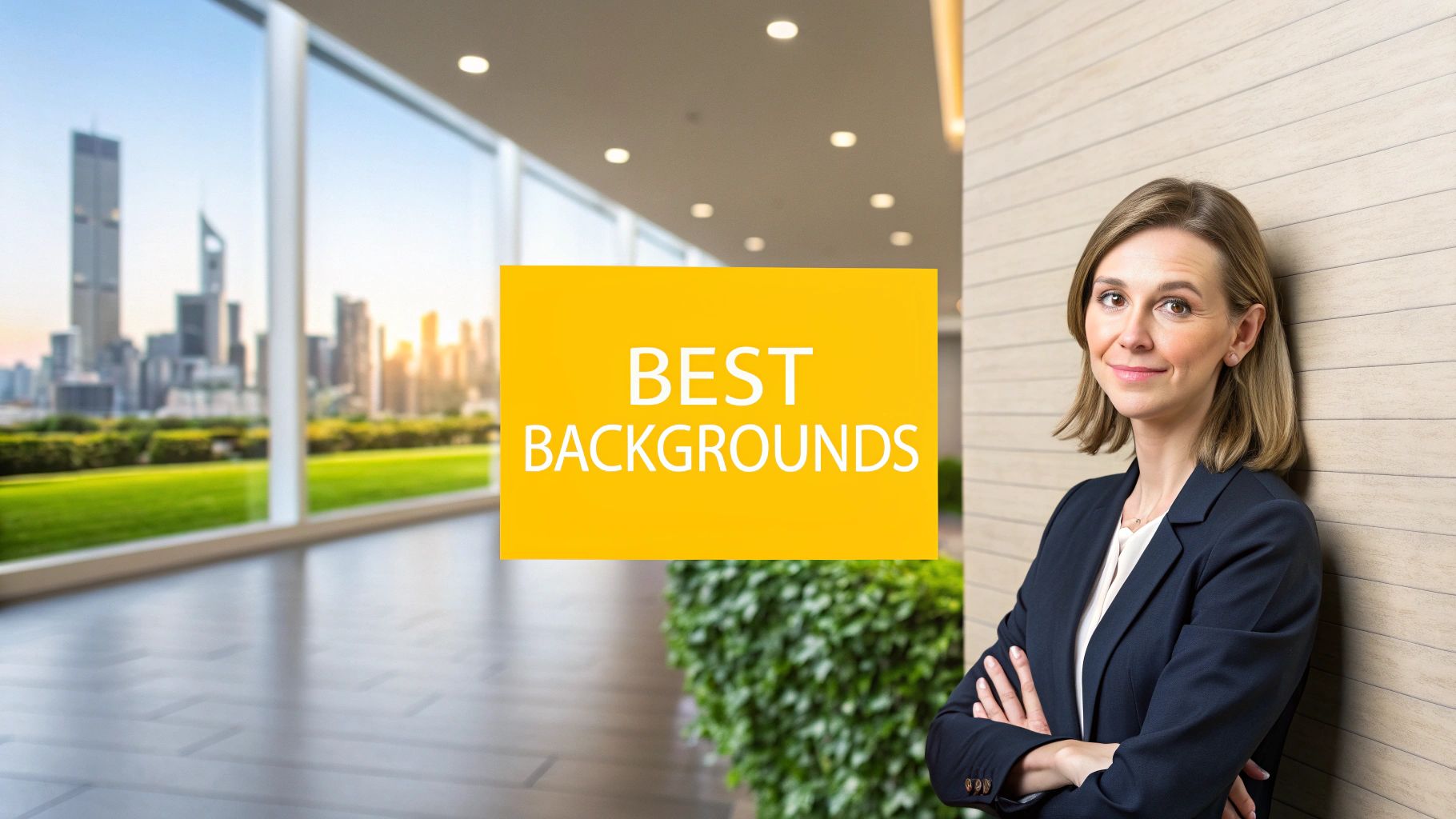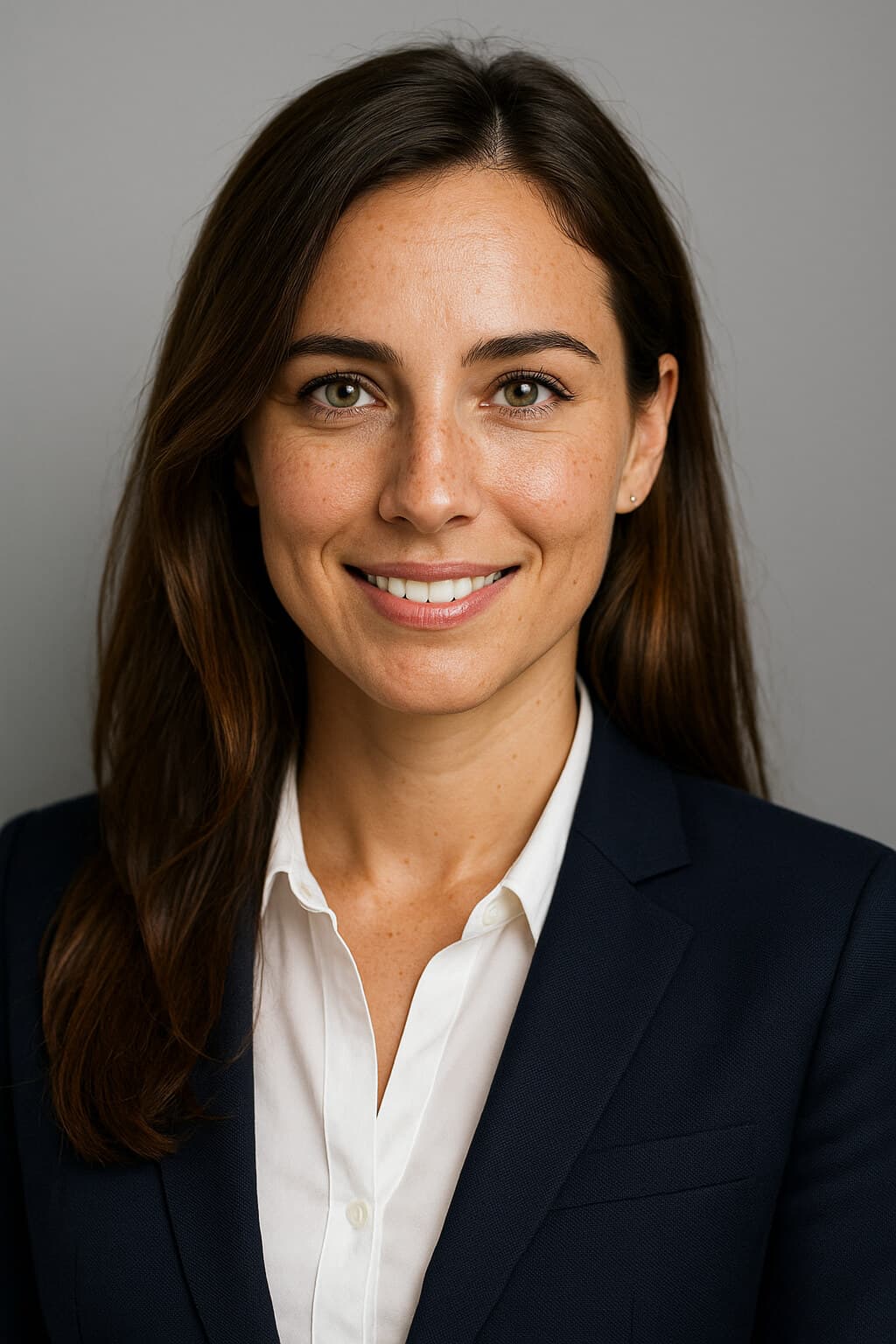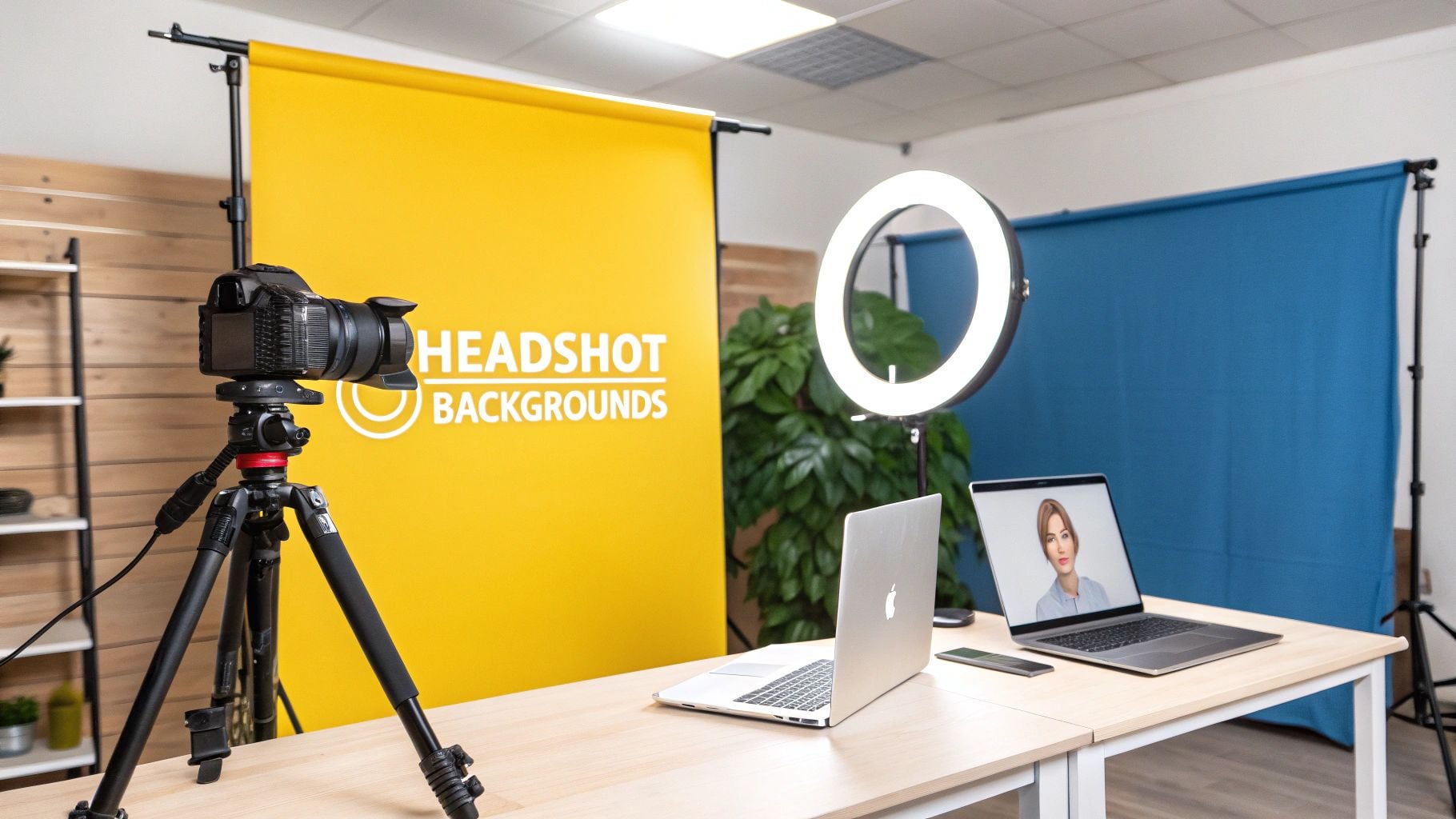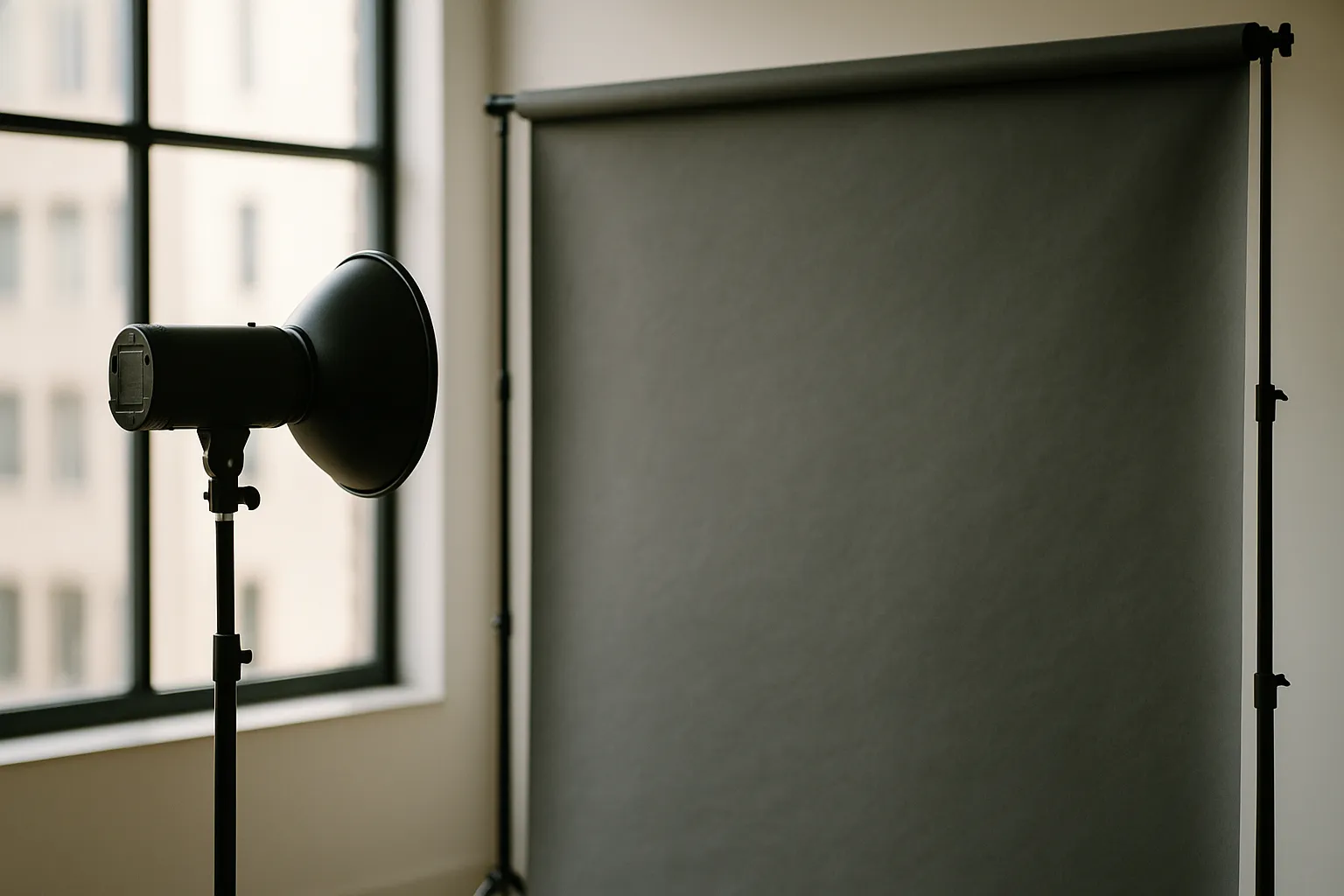In today's professional landscape, your business headshot is often the first impression you make. Whether on LinkedIn, a company website, or a resume, a polished photo signals credibility. While most people focus on their smile or outfit, the background plays an equally critical role. The right setting can enhance your professionalism and align with your brand, while a poor choice can be distracting and undermine your message.
This guide explores the most effective options to help you choose the best background for your business headshot. We will cover timeless studio looks, modern environmental portraits, and how to select the right style for your industry and career goals. For those needing a high-quality solution without a traditional photoshoot, AI-generated headshots from services like HeadyShot offer excellent flexibility, letting you test and select the perfect backdrop from home.
1. Plain White Background
A plain white background is a classic choice for a business headshot, offering a look that is clean, timeless, and versatile. It is a standard in the corporate world because it removes all visual distractions, ensuring the sole focus is on you. This makes it an ideal selection for anyone seeking a trustworthy and polished image, from executives and lawyers to medical professionals and consultants.
This background style projects clarity and confidence, making it a powerful tool for platforms like LinkedIn, corporate websites, and annual reports. The simplicity ensures your headshot remains relevant for years, fitting easily into various marketing materials without clashing with different designs.
Key Considerations for a White Background
Achieving a flawless white background requires attention to technical details, particularly lighting. The goal is to create an evenly lit, pure white space that makes you stand out.
- Lighting is Crucial: A professional setup uses at least two lights—one for the subject and another for the background. The background light should be brighter than the light on your face to eliminate shadows and create a pure white look.
- Create Separation: Stand at least three to six feet away from the backdrop. This distance prevents your shadow from falling onto the background and stops light from spilling onto your shoulders and hair.
- Clothing Choices: Avoid wearing white or very light-colored clothing, as it can blend into the background. Opt for colors that create a pleasant contrast and define your silhouette.
For those looking to achieve this professional look without a physical studio, AI-powered tools can be very effective. AI headshot generators like Headyshot can generate studio-quality headshots with a clean white background from your existing photos, saving you the time and complexity of a photoshoot.
The infographic below summarizes the core benefits of choosing a plain white background.
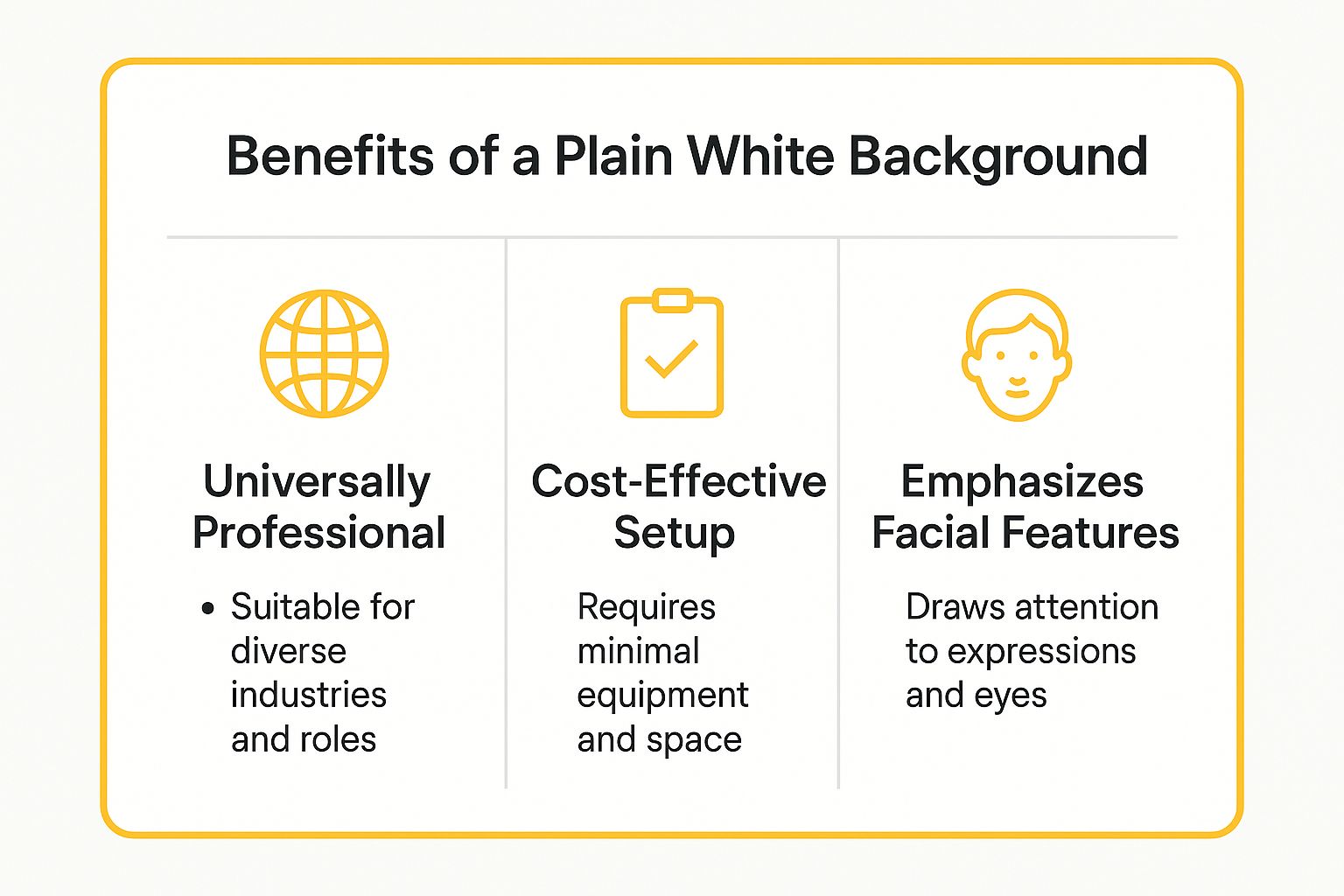 As the summary shows, the appeal of a white background lies in its universal professionalism and ability to draw attention directly to your facial expression.
As the summary shows, the appeal of a white background lies in its universal professionalism and ability to draw attention directly to your facial expression.
2. Neutral Gray Background
A neutral gray background is a sophisticated and modern alternative to white, offering a professional look with added depth and warmth. This versatile choice strikes a perfect balance between approachability and authority. It’s an excellent option for professionals who want their headshot to feel contemporary and refined, from tech executives and financial consultants to real estate agents.
Gray provides a subtle, distinguished canvas that helps you stand out without the starkness of a pure white backdrop. It complements nearly all skin tones and clothing colors, ensuring a harmonious and polished final image. This makes it one of the best background choices for a business headshot intended for corporate websites, LinkedIn profiles, and marketing materials.
Key Considerations for a Gray Background
Creating a professional gray background involves more than just a gray wall; lighting is key to achieving a high-end look. The goal is to create a soft, even tone that enhances your features.
- Lighting for Depth: A key advantage of gray is the ability to create a subtle gradient. By placing a light source to one side of the background, you can create a gentle light-to-dark transition that adds dimension.
- Enhance Subject Definition: Stand three to five feet away from the gray backdrop. This prevents shadows and allows space for a "rim light" behind you, which creates a crisp outline that separates you from the background.
- Clothing Choices: While gray is very forgiving, jewel tones like emerald green, sapphire blue, and deep red often pop beautifully. Pastels and mid-tone colors also work well, creating a softer, more understated look.
For professionals seeking this refined look without the hassle of a studio session, AI offers a powerful solution. AI headshot generators can produce flawless headshots with a perfect neutral gray background, giving you a sophisticated image from the comfort of your home.
3. Soft Colored Background
Moving beyond neutral shades, a soft colored background introduces personality and brand alignment while maintaining professionalism. Muted tones like soft blue, sage green, or warm beige create a sophisticated and modern feel. This style is an excellent choice for professionals and companies wanting to appear more approachable and innovative, such as creative directors, wellness coaches, and marketing teams.
This background choice subtly communicates brand values and adds a layer of warmth that can make you seem more relatable. For example, a marketing agency might use its brand's signature blue, while a healthcare professional could opt for a calming sage green. This makes it a great background option when you need to blend personality with professionalism.
Key Considerations for a Soft Colored Background
Choosing the right color requires a strategic approach to ensure it enhances your image and aligns with your professional brand.
- Align with Brand Palette: If your company has established brand colors, select a muted version for your headshot background. This creates a cohesive and recognizable visual identity.
- Consider Color Psychology: Colors evoke specific emotions. Blue often conveys trust and stability, green suggests growth and tranquility, and warm tones like beige can feel approachable and friendly. Choose a color that reflects the impression you want to make.
- Test Against Skin Tones: Not every color complements every skin tone. It’s wise to test a few options to see which one makes you look your best. The color should make you stand out, not wash you out.
- Keep Saturation Low: To maintain a professional look, stick to soft, desaturated colors. Bright, vibrant hues can appear unprofessional and may not reproduce well across different screens.
For those who want to experiment with various colors, an AI-powered service is an ideal solution. Tools like Headyshot can generate a wide array of headshots with different soft colored backgrounds, allowing you to find the perfect shade that complements your brand and personal style.
4. Blurred Office or Workplace Environment
Using a softly blurred office or workplace environment as your background provides context about what you do without being distracting. This technique, often called an "environmental portrait," creates an image that feels authentic and tells a story about your profession. This makes it an excellent choice for architects, consultants, and executives who want to connect with their audience on a deeper level.

This style is particularly effective for "About Us" pages and LinkedIn profiles where conveying your professional environment adds value. A lawyer with a backdrop of law books or an architect with drafting models subtly communicates expertise. It makes the headshot feel less staged and more integrated into your professional identity.
Key Considerations for a Blurred Workplace Background
Achieving a beautifully blurred background, or "bokeh," requires a specific photographic approach that separates you from your surroundings.
- Use a Wide Aperture: The photographer should use a lens with a wide aperture (f/1.4 to f/2.8). This narrows the plane of focus, keeping you sharp while rendering the background into a soft, pleasing blur.
- Create Distance: Stand at least six to ten feet away from the background elements. The greater the distance between you and the background, the more pronounced the blur will be.
- Scout the Location: Look for a background with interesting shapes and light that will look good when blurred. A cluttered or messy background will still look messy when blurred, so choose a tidy and aesthetically pleasing setting.
- Balance the Lighting: Ensure the lighting on you is stronger than the light in the background. This helps you stand out and prevents the background from becoming a washed-out distraction.
For those who want this authentic, environmental look without the logistical challenges of a location photoshoot, AI offers a powerful solution. Most tools can expertly place your image against a professionally blurred office setting, giving you a sophisticated and contextual headshot.
5. Textured Wall or Backdrop
A textured wall or backdrop introduces a layer of sophistication and depth, making it an excellent choice for a business headshot that needs to feel premium and visually engaging. Unlike a flat background, subtle textures from fabric, painted canvas, or even concrete can add character without overwhelming the subject. This style is effective for professionals in creative industries, luxury markets, or anyone aiming for a refined, high-end aesthetic.
This background choice elevates your image, suggesting attention to detail and a modern sensibility. It works beautifully for creative directors, high-end consultants, and designers who want their headshot to reflect their unique brand personality. The added dimension creates a portrait that is both professional and artistically compelling.
Key Considerations for a Textured Background
Using texture effectively requires a delicate balance; the goal is to enhance, not distract. The right lighting and texture selection are critical to achieving a polished, professional look.
- Lighting is Key: Use side lighting to gently graze the surface of the backdrop. This technique, known as "raking light," will accentuate the texture by creating soft highlights and shadows.
- Complement Your Attire: The texture and color of the backdrop should complement your clothing, not compete with it. A busy pattern on the wall combined with a patterned shirt can be visually chaotic.
- Keep it Subtle: The best textured background for a business headshot is one that adds a tactile quality and visual interest that supports your presence, rather than drawing focus away from you.
6. Natural Outdoor Environment
A natural outdoor environment can serve as an excellent background for a business headshot when aiming for an approachable and authentic image. This style moves away from the corporate studio, leveraging natural light and scenery to convey a down-to-earth persona. It is a great choice for professionals in sustainability, environmental consulting, real estate, or any field connected to the outdoors.
This background connects you to your environment, creating a memorable brand story. For instance, a sustainable business leader photographed in a lush green space instantly communicates their commitment to nature. The organic setting helps soften the professional image, making you appear more relatable and trustworthy.
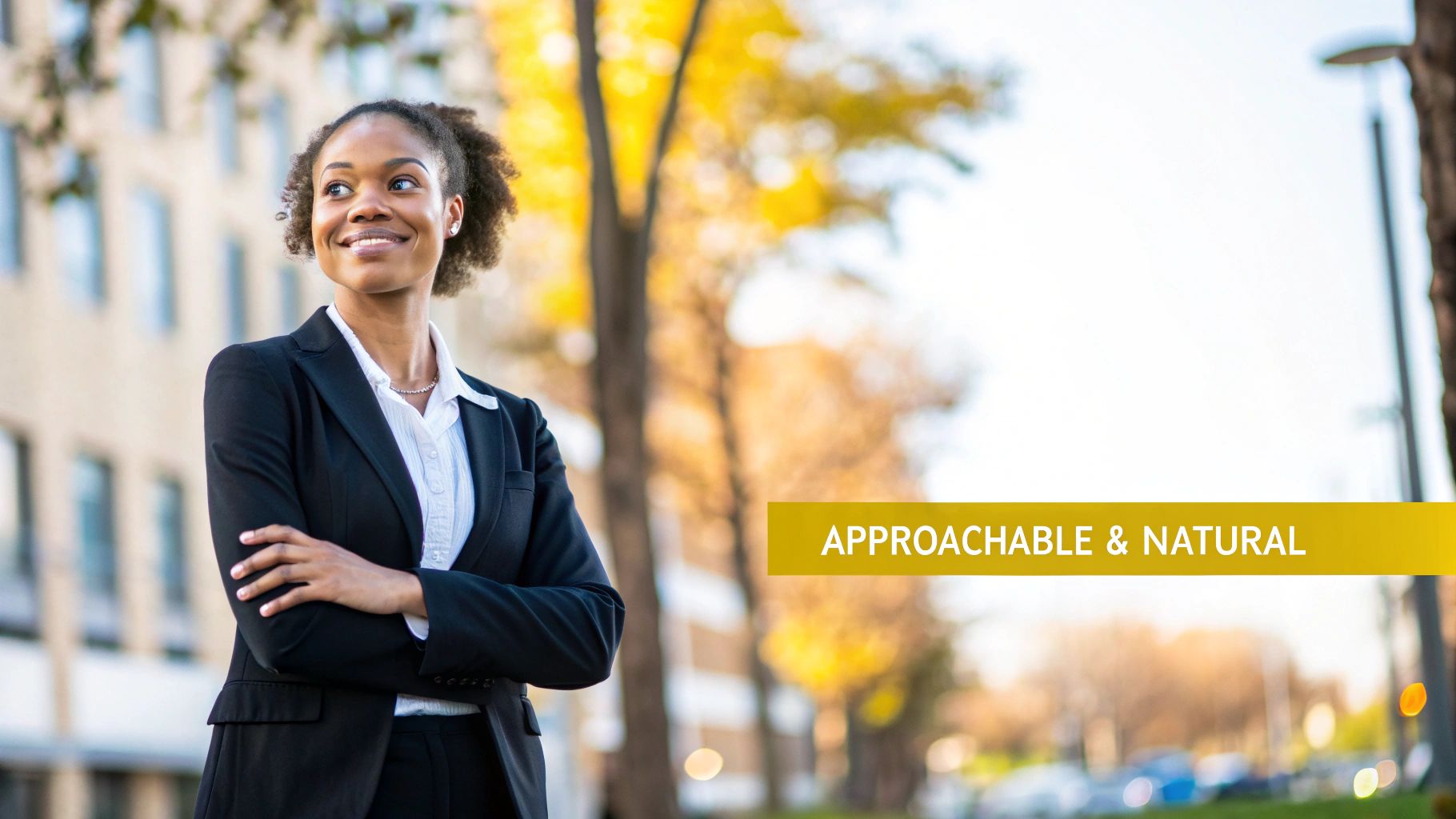
Key Considerations for a Natural Outdoor Environment
Capturing a professional headshot outdoors requires careful planning to manage natural elements and achieve a polished look.
- Master the Light: Shoot during the "golden hour"—the first hour after sunrise or the last hour before sunset. This timing provides soft, flattering light that minimizes harsh shadows. Overcast days also provide excellent, diffused light.
- Blur the Background: Use a camera lens with a wide aperture (a low f-stop number like f/2.8) to create a shallow depth of field. This will softly blur the background, making you the clear focal point.
- Scout Your Location: Visit the potential shooting location beforehand to identify the best angles, lighting conditions, and background elements. Look for spots that are visually interesting but not distracting.
- Plan for Contingencies: Weather is unpredictable. Always have a backup indoor location planned in case of rain or strong winds.
Achieving this look traditionally requires a skilled photographer and ideal weather. However, AI headshot generators can place your image against a perfectly lit, natural outdoor setting, offering a reliable and convenient alternative.
Choosing the Best Background for Your Headshot
The background you choose is a strategic tool that frames your professional identity. From the classic authority of a plain white or neutral gray background to the approachable warmth of a soft color, each option communicates a distinct message.
A blurred office environment can signal industry expertise, while a natural outdoor setting can convey authenticity. The best background for your business headshot is the one that aligns seamlessly with your industry, personal brand, and the audience you wish to attract.
How to Choose Your Background
Here are a few steps to help you decide:
- Define Your Brand: First, clarify your personal brand. Are you innovative, traditional, approachable, or authoritative?
- Analyze Your Industry: Look at the headshots of leaders in your field on platforms like LinkedIn. Identify common background trends and decide if you want to conform or strategically stand out.
- Consider Your Audience: Think about who you are trying to reach. A corporate recruiter might respond best to a traditional studio background, while a creative agency may prefer something more dynamic.
Choosing the right background is a key step, but executing it perfectly can be challenging and expensive. Coordinating photographers, studios, and locations takes time and resources. This is where technology offers a powerful alternative. Modern AI can generate a wide array of high-quality, professional headshots from just a few of your existing photos, giving you complete control over the final look, including the perfect background.
Ready to get a studio-quality portrait without the hassle? Explore the AI headshot generator from Headyshot to create a polished, professional image. Choose from dozens of styles and the best backgrounds for business headshots to find the one that best represents you and your brand, and receive a collection of high-resolution photos in minutes.
